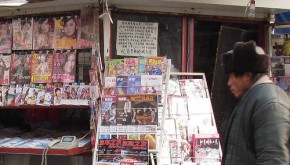European news is dominated by white, middle aged men. While men over the age of 40 feature in three-quarters of news stories, women are the protagonists in only a quarter of news, according to new research. Migrants, immigrants, disabled and other minorities have mainly secondary or minor roles. Mediane, a project set up to study how to increase diversity in European media, has called for urgent changes in the way journalists are trained and recruited. It has also concluded that sources of information, and news experts, must be diversified to better reflect contemporary society.
Mediane (Media in Europe for Diversity and Inclusiveness) is a joint Council of Europe and European Union initiative, held over two years, between 2013 and 2014. It found that women represent half of Europe’s population yet they feature in only about 25 per cent of published news, even less – five per cent – in economic and scientific news. Migrants, representing about 10 per cent of Europe’s population, feature in only about five per cent of news, according to data from the World Association for Christian Communication (WACC).
A study by the Higher Belgian Audiovisual Council (Conseil Supérieur de l’Audiovisuel) concluded that people with disabilities occupy mostly secondary roles in the news, and almost always about issues related to disability. Members of the lesbian, gay, bisexual and transgender communities make up six per cent of the population in the UK, yet feature in less than one per cent of news coverage.
The Council of Europe and the EU are trying to reverse this trend. Mediane has consulted widely, through a series of plenary sessions and working groups held with journalists, students and journalism professors, and also with media companies, across Europe. Mediane has also launched an online tool to help raise awareness of the need for diversity. Last month the two-year program ended with a conference in Brussels, attended by 150 European experts including representatives from broadcasting, journalism unions and media researchers.
At the conference France Télévisions, the French public service, described a barometer it has developed to analyse sources and experts used in researching news stories. It reports the results to its editors and journalists. “The effect was a greater diversity in the selection and better representation of society on television,” said the Director-delegate for the diversity of information, Stéphane Bijoux.
Bijoux advised journalism schools to select students from different backgrounds, including the most disadvantaged: “We are a public service and more than diversify; we must have society reflected in the company”. This practice is already followed in France at the Institute of Journalism Bordeaux Aquitaine, which selects 35 candidates annually, among 800, with diversity in mind. However, background makes little difference to their journalism, according to Bijoux: “Although coming from deprived backgrounds they are not more sensitive to social problems. Everyone prefers covering sports or culture. We have to tell them to diversify the topics of the news. There is a tendency for self-normalization which comes into conflict with our efforts at recruitment. But the fact they have different backgrounds enriches them all and changes the angles of approach of the news,” said Brigitte Besse, who is responsible for recruiting candidates for the program.
The same approach is being adopted in Belgium’s French-speaking public channel, RTBF, whose general administrator, Jean-Paul Philippot, has had a team working on the monitoring of the news, since 2012: “You have to innovate and diversify,” he said. He described this process as “Innoversity”.
Hiring professionals to newsrooms, from different social and cultural backgrounds, was another recognized need, but media companies represented at the conference, from Italy, Germany, Sweden, France, England, Ireland and Belgium, generally agreed that fewer journalists are being hired now. Instead, they recruit trainees and some of these get temporary contracts. However Michael Smith, of the UK’s National Union of Journalists, questioned this: “There are many young people who are exploited by the media business because they work for free or are paid symbolically, even when they do the work of professional journalists… There is also the ethical question. How can they follow rules of professional conduct and independence if fighting is for survival and for a place on a board?”.
The ‘Mediane Box’, an online application (in French and English) aimed at journalists, journalism professors and media industry, was also launched at the conference. The app is designed to help media practitioners to monitor their diversity and inclusion practices. Users will also have access to multimedia resources which can assist them in the change of practices. The ‘Mediane Box’ was developed by Myria Georgiou, Associate Professor at the Department of Media and Communications, at the London School of Economics and Political Science (LSE). Her team at the LSE was helped by about 500 professionals, 80% of them journalists, but also teachers, company executives and representatives of associations. Now it is up to the participants to spread the word.
Tags: European Union, Journalism Education, Journalism research, Journalistic Diversity, Media research












































